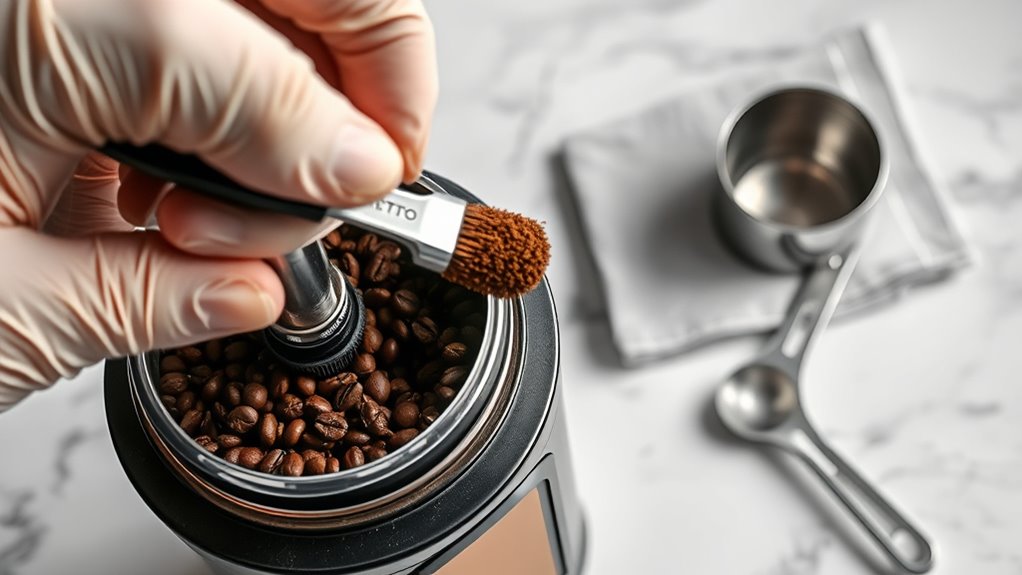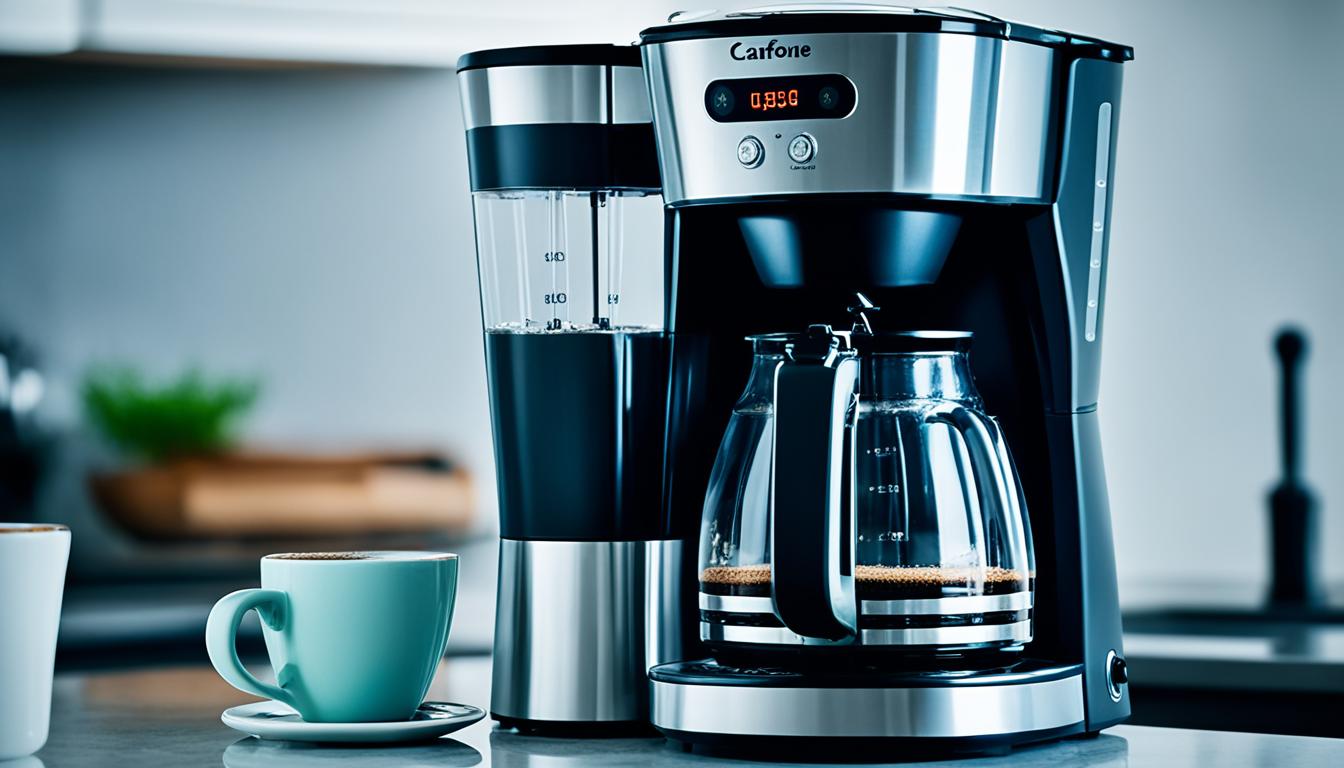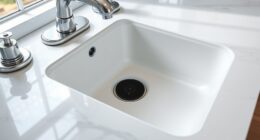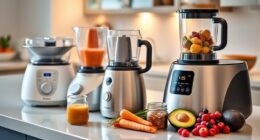To measure your coffee grinder’s cleanliness, start by inspecting for visible residue, oils, or buildup on burrs and chamber. Perform a taste test with brewed coffee to check for off-flavors, and use a small brush or vacuum to clear away grounds. Keep track with a regular cleaning schedule—quick cleans weekly and deep cleans monthly—to guarantee ideal performance. Want to know more about precise methods? Keep exploring for detailed tips on maintaining your grinder.
Key Takeaways
- Visually inspect burrs, chamber, and exterior for coffee residues, oils, and buildup before cleaning.
- Use a small brush or cloth to gently remove surface grounds and oils, then wipe with a damp cloth.
- Run a small batch of rice or baking soda through the grinder to gauge residue removal effectiveness.
- Assess aroma and flavor of brewed coffee to detect lingering oils or stale residues indicating cleaning needs.
- Track cleaning frequency and residue levels over time to ensure consistent maintenance and optimal performance.
Recognizing Visual Signs of Cleanliness
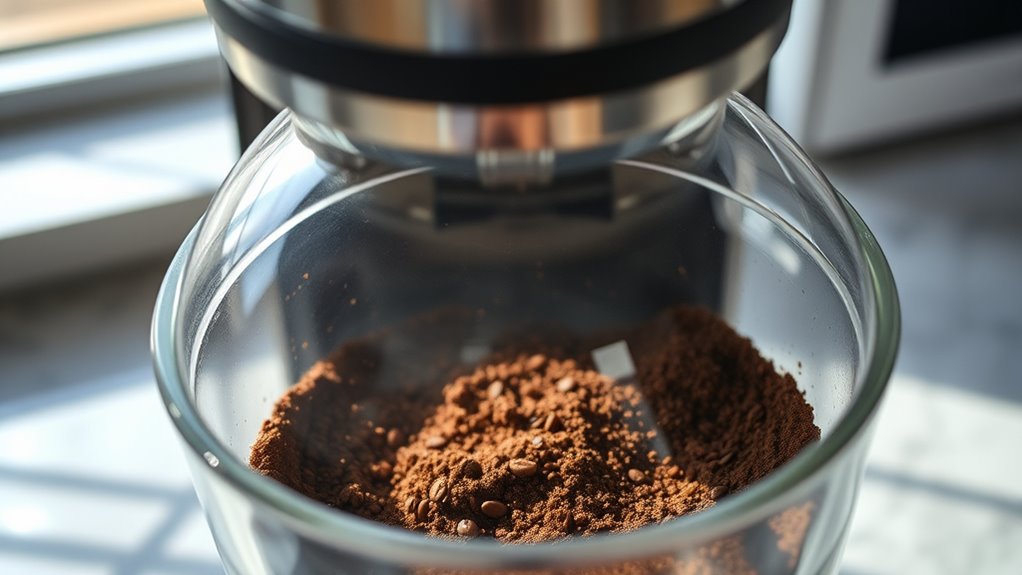
To determine if your coffee grinder is clean, start by inspecting its visible parts for signs of residue and buildup. Look closely at the burrs or blades, checking for dark oil or old grounds. If you notice lingering coffee particles or a greasy film, it’s time to clean. Regular cleaning frequency depends on how often you grind coffee; daily use requires more frequent cleaning. Also, consider your storage methods—storing your grinder in a humid or dusty area can promote residue buildup. A clean grinder should have a consistent, dry appearance without any visible coffee oils or clumps. If things look grimy or oily, it’s a sign you need to clean it to maintain ideal performance and flavor. Visual signs like these help you gauge when your grinder needs attention. Additionally, ensuring proper filter maintenance can prevent buildup and keep your grinder functioning smoothly over time.
Using Baking Soda or Rice for Deep Cleaning
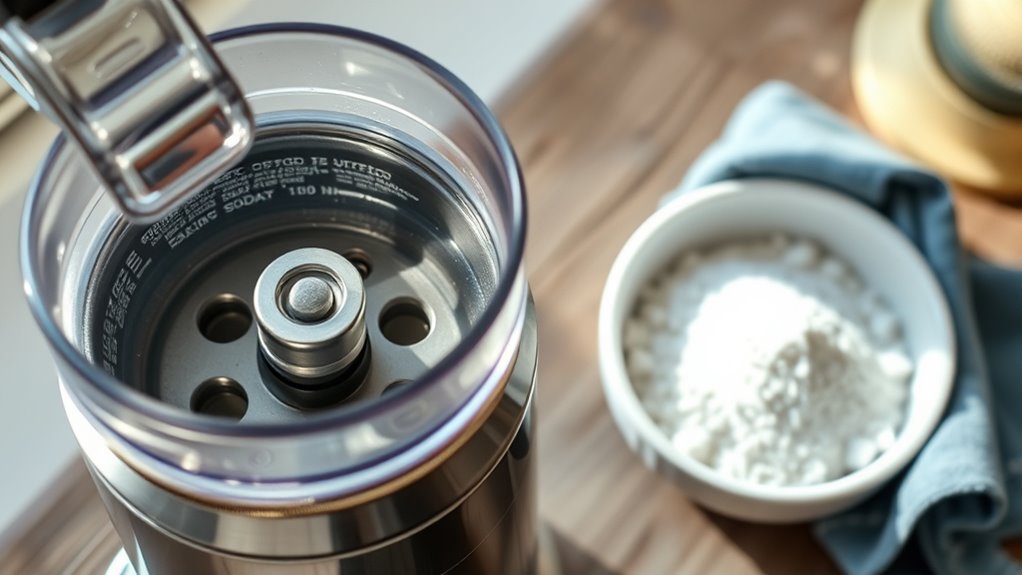
Baking soda and rice are popular options for deep cleaning your coffee grinder because of their abrasiveness. Baking soda helps break down residue without damaging the grinder, while rice can absorb oils and loosen debris. Both methods can effectively refresh your grinder when used properly. Using rice is also a quick way to remove oil buildup, which can affect the flavor of your coffee.
Effectiveness of Baking Soda
While baking soda is often praised for its cleaning power, it can be particularly effective for deep cleaning your coffee grinder when used properly. Baking soda’s mild abrasive qualities help remove stubborn residues without damaging the grinder’s components. Its versatility ensures compatibility with most grinder materials, but you should always check for grinder material compatibility to prevent corrosion or surface damage. Using baking soda can enhance coffee grinder durability by reducing buildup that may impair performance over time. When applied correctly, it cleans deeply without harming sensitive parts like burrs or blades. Keep in mind that improper use might scratch or corrode certain materials, so always follow manufacturer instructions and test on a small area first. Properly used, baking soda can maintain your grinder’s efficiency and longevity. Additionally, understanding the ethical hacking principles can help you identify vulnerabilities in your cleaning tools or routines, ensuring your methods remain secure and effective.
Rice as an Abrasive
Using rice as an abrasive can be an effective way to deep clean your coffee grinder, especially when combined with other cleaning agents like baking soda. The rice helps remove stubborn residues and oils, improving grinder maintenance. To guarantee proper cleanliness, watch for indicators like reduced residue buildup and consistent grinding performance. When using rice, pour a small handful into the hopper and run the grinder briefly. The rice acts like a scrubber, loosening debris. Afterward, discard the rice and wipe the grinder. For added effectiveness, incorporate baking soda for extra cleaning power. Remember, keeping an eye on cleanliness indicators ensures your grinder remains efficient and free of old coffee oils. Regular maintenance can also prevent buildup and extend the lifespan of your equipment.
Measuring Residual Coffee Grounds and Oils
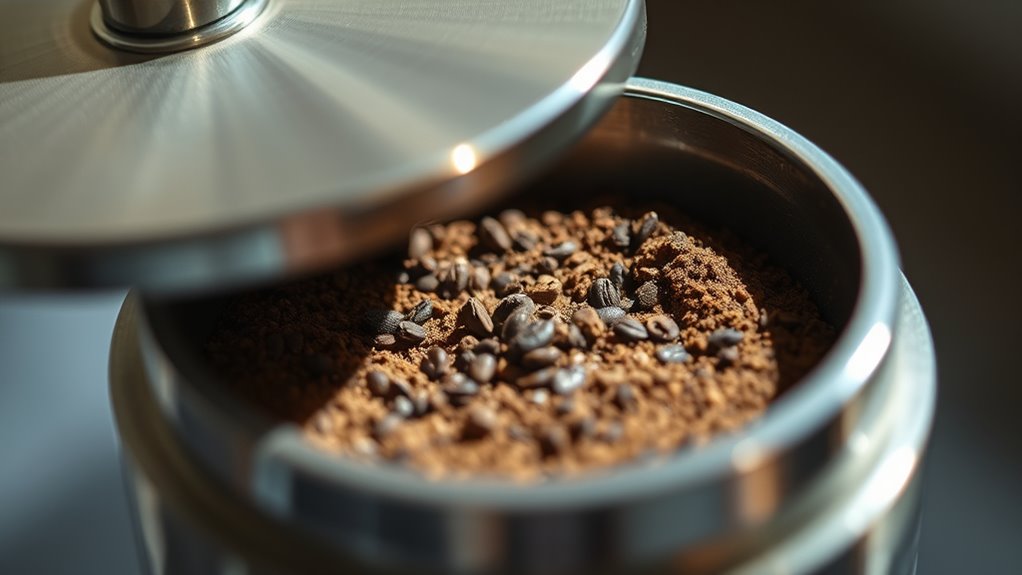
To accurately measure residual coffee grounds and oils in your grinder, start by inspecting the burrs and chamber for visible buildup. Measuring residuals involves checking for leftover coffee particles that can affect flavor and grind consistency. Oil analysis helps determine how much oil has accumulated, which can lead to rancidity or machine clogging. Use a small brush or cloth to gently remove surface residues, then wipe the area with a damp cloth to assess the remaining buildup. If you notice sticky or oily spots, it indicates significant oil deposits. Regular measurement of residual coffee grounds and oils ensures you catch buildup early, maintaining ideal grinder performance. Keeping track of these residues allows you to decide when a deep clean is necessary, preserving the freshness of your brew. Additionally, understanding angel numbers can offer spiritual guidance on maintaining harmony and balance in your routine cleaning process.
Performing a Taste Test to Detect Old Flavors
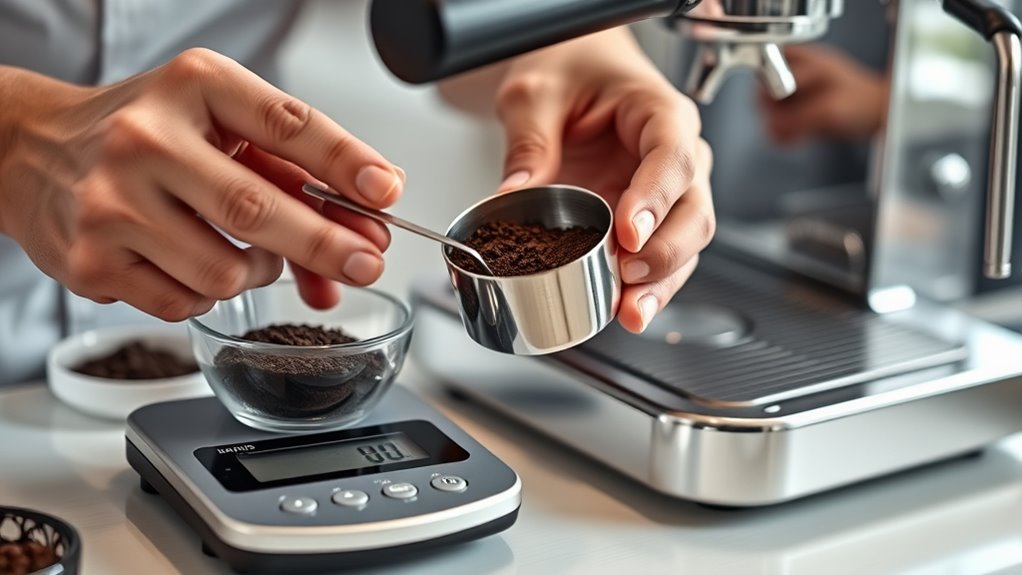
Performing a taste test is an effective way to detect old or stale flavors that may indicate your grinder needs cleaning. When you brew a cup, pay close attention to the coffee aroma and flavor. If it smells dull or tastes flat, it could be a sign of residual oils or stale coffee buildup in your grinder. Regular grinder maintenance helps preserve the fresh aroma and vibrant flavors you expect from your coffee. To test, brew a small batch of coffee using your regular grind settings, then taste it. If you notice off-flavors or a lingering aftertaste, it’s time to clean your grinder thoroughly. This simple step ensures your grinder stays in top condition, maintaining ideal coffee aroma and flavor extraction. Additionally, staying aware of AI vulnerabilities can help you implement better safety measures for your coffee-making setup.
Utilizing a Brush or Vacuum for Residue Removal
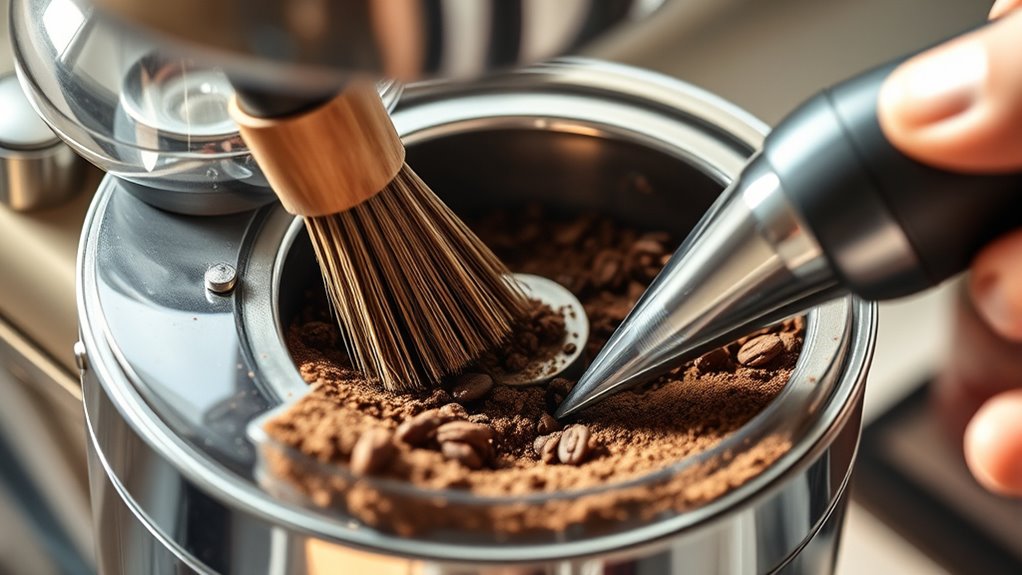
Choosing the right brush or vacuum is key to effectively removing residue from your grinder. Use gentle techniques to loosen and clear out coffee grounds without damaging the equipment. Always handle your tools carefully to stay safe and keep your grinder in top shape. Proper cookie management can also help maintain your device’s performance and longevity.
Selecting the Right Tool
Selecting the right tool is essential for effectively removing residue from your coffee grinder. When it comes to grinder maintenance, using a brush or vacuum can make a significant difference. A small, stiff-bristled brush works well to dislodge coffee bean particles stuck in the burrs and crevices, ensuring a thorough clean. If you prefer using a vacuum, choose one with a narrow nozzle to reach tight spaces without disturbing your grinder’s delicate parts. Both tools help prevent leftover coffee oils and debris from affecting the flavor of your next brew. Avoid using water or damp cloths, as moisture can damage your grinder. Regular cleaning with proper tools can also reduce spiritual distraction and keep your focus centered during your brewing process. By choosing the appropriate tool, you’ll maintain ideal performance and extend your grinder’s lifespan.
Effective Residue Removal Techniques
Using the right tools makes a noticeable difference when removing residue from your coffee grinder. Regular cleaning frequency is key to maintaining grinder performance and flavor quality. A soft brush is effective for dislodging coffee grounds stuck in burrs and crevices, while a handheld vacuum helps remove loose particles from hard-to-reach areas. Consistently using these tools prevents buildup, reducing the need for more intensive cleaning sessions. Incorporate these techniques into your grinder maintenance routine to keep your machine in excellent condition. Remember, frequent cleaning not only ensures better-tasting coffee but also prolongs the lifespan of your grinder. By adopting simple yet effective residue removal methods, you’ll keep your grinder running smoothly and maintain the freshest brew every time. Understanding industry trends can help you stay updated on best practices for your equipment.
Ensuring Safe Handling
To guarantee safe handling during residue removal, it’s important to handle your brush or vacuum carefully to avoid damaging your grinder. Using gentle pressure prevents scratches and preserves your grinder’s components, ensuring consistent coffee flavor. Be cautious when maneuvering around sensitive parts to avoid dislodging or breaking anything, which could compromise grinder maintenance. Additionally, understanding the importance of Kia Tuning can help you appreciate how proper maintenance and care contribute to optimal performance.
- Use soft-bristled brushes to gently sweep away residue
- Keep the vacuum nozzle at a safe distance from delicate parts
- Avoid excessive force that could damage the grinder’s burrs
- Regularly inspect your tools for wear to maintain effective cleaning
Following these tips helps you remove residues safely, preserving your grinder’s performance and ensuring optimal coffee flavor with every brew.
Establishing a Regular Cleaning Schedule
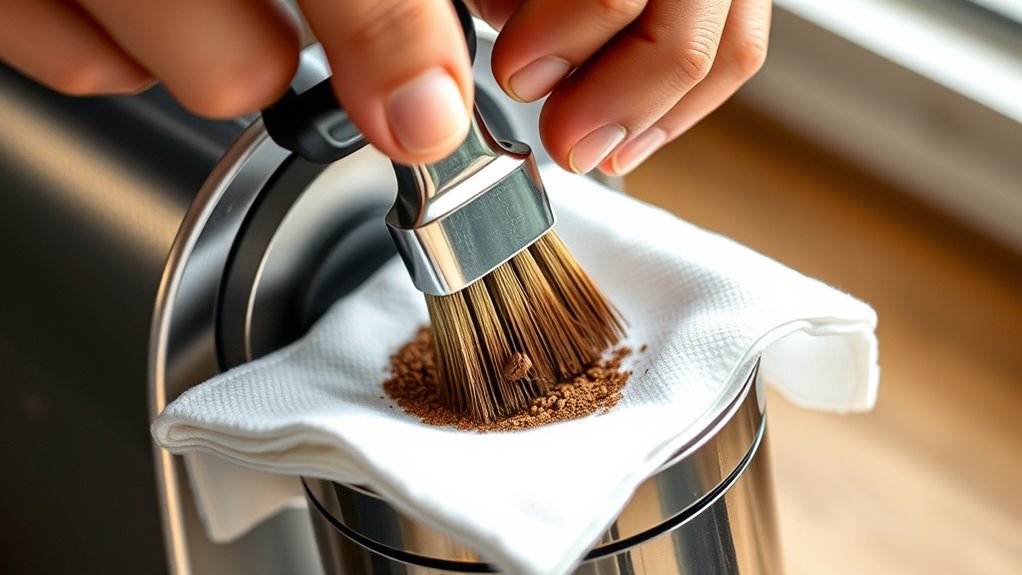
Establishing a regular cleaning schedule is essential to maintaining your coffee grinder’s performance and ensuring your coffee tastes fresh. When you clean your grinder consistently, you prevent old coffee residues from affecting the coffee flavor and build-up that can harm the grinder’s components. How often you clean depends on usage, but a good rule of thumb is to do a quick clean weekly and a thorough deep clean monthly. Regular maintenance prolongs grinder longevity by reducing wear and tear on the burrs or blades. Using the right cleaning tools and methods helps keep everything in *ideal* condition. Additionally, understanding the importance of proper headphones compatibility and maintenance can help prevent damage when connecting different devices. By sticking to a schedule, you’ll enjoy consistently fresh coffee and extend the lifespan of your grinder, saving you money in the long run.
Frequently Asked Questions
How Often Should I Calibrate My Coffee Grinder for Optimal Cleanliness?
You should calibrate your coffee grinder at least once a month to maintain ideal cleanliness benchmarks. Regular grinder calibration ensures consistent grind size, which helps prevent old coffee residues from affecting flavor and cleanliness. If you notice uneven grounds or flavors changing, it’s a sign to calibrate sooner. Staying on top of grinder calibration keeps your equipment clean and your coffee tasting fresh every time.
Can Cleaning Methods Vary Based on Different Grinder Models?
Think of your grinder as a musical instrument — different models require different care. You’ll find that grinder material considerations influence cleaning method compatibility; for example, burrs made of ceramic need gentle brushes, while metal parts might handle more robust cleaning. Always check your manufacturer’s instructions because what works for one model might damage another. Adjust your cleaning approach accordingly to keep your grinder singing perfectly.
What Are the Safety Precautions During Deep Cleaning Procedures?
During deep cleaning, always wear safety gear like gloves and eye protection to prevent contact with cleaning agents or debris. Make certain electrical safety by unplugging your coffee grinder before disassembling or cleaning, avoiding water contact with electrical parts. Handle all parts carefully, and follow manufacturer instructions. Keep the workspace dry, and never operate the grinder while it’s wet or not fully reassembled, reducing risks of electric shock or damage.
How Do Environmental Factors Affect the Cleanliness Measurement?
Environmental factors like air quality and humidity levels directly impact your cleanliness measurements. Poor air quality can introduce dust and pollutants that skew results, making it seem dirtier than it truly is. High humidity can cause residue to cling more stubbornly or promote mold growth, affecting cleanliness assessments. To guarantee accurate measurements, keep your environment well-ventilated, control humidity, and regularly monitor air quality to prevent misleading results.
Are There Eco-Friendly Cleaning Alternatives for Coffee Grinders?
Yes, you can opt for eco-friendly cleaning alternatives like biodegradable cleaners that break down naturally and are safe for the environment. Additionally, using reusable cloths helps reduce waste and effectively cleans your coffee grinder without harsh chemicals. You just need to apply biodegradable cleaners to a reusable cloth, wipe the grinder thoroughly, and rinse with water. This approach keeps your grinder clean while supporting eco-conscious practices.
Conclusion
By following these simple steps, you’ll keep your coffee grinder shining like new. Regular cleaning is your secret weapon, preventing old flavors from sneaking into your brew. Think of it as tuning your musical instrument—every part needs care for the perfect sound. When you measure, inspect, and clean consistently, your coffee’s flavor will flourish like a garden in full bloom. Stay diligent, and your grinder will serve up the best cup every time.
